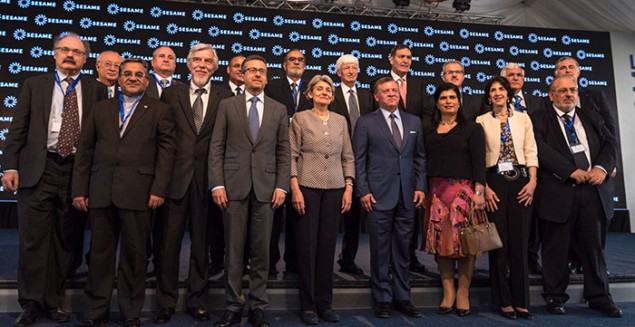
A scientific facility designed to foster collaboration in the Middle East is finally open after taking 15 years to build. The Synchrotron-light for Experimental Science and Applications in the Middle East (SESAME) was officially opened yesterday by King Abdullah II of Jordan in a ceremony at the lab’s site near Amman, Jordan. SESAME is a third-generation synchrotron light source and will be used by scientists in the region for a range of experiments from condensed-matter physics to biology.
The synchrotron, which has a relatively small 133 m circumference, features an 800 MeV pre-booster ring that sends a beam of electrons to the main storage ring that in turn boosts their energies to 2.5 GeV – a feat that was first achieved on 27 April – with the particles then producing intense and monochromatic beams of X-rays. Over the past year, construction accelerated with the core storage ring put together with magnets built by the CERN particle-physics lab near Geneva. Initially, two beamlines will be open for users, with more added at a later date.
Harmonic start-up
Swiss physicist Albin Wrulich, who chairs the SESAME Technical Advisory Committee, points out that SESAME is currently undergoing a “conditioning” phase that includes adjusting the pressure and cleaning the surface of the vacuum chamber. “The performance of the machine is excellent,” says Wrulich, adding that the local team did a “fantastic job” constructing the synchrotron. He says that the first two beamlines can now be turned on, making for a “harmonic” start-up.
SESAME has eight members – Cyprus, Egypt, Iran, Israel Jordan, Pakistan, the Palestinian Authority and Turkey – and the synchrotron’s proponents hope that it will foster regional scientific capacity and friendly collaboration among scientists from different countries. Physicist Chris Llewellyn Smith, the former director general of CERN who is ending his eight-year presidency of the SESAME Council today, says that in March SESAME received 55 experiment proposals for the first beamtime. “It shows that SESAME is not going to be underused,” he says. “There is a real demand out there.”
Llewellyn Smith adds that countries in the region whose researchers use SESAME should hopefully consider joining while researchers from countries with synchrotrons should invite regional researchers to join them or instruct local scientists as to synchrotron techniques. “SESAME, in common with all the synchrotrons of the world, will have an open-door policy,” he adds.
Future-proof
SESAME officials are even planning upgrades for the near-future. Wrulich says that there is already interest in upgrading the machine’s booster from 800 MeV to a 2.5 GeV, which would enable the storage ring to sustain a consistently intense beam. The Italian government has also come forward with financial support for a SESAME guest house, and Llewellyn Smith expects the building contract to be finalized soon.
Meanwhile, a European Union programme to support renewable-energy efforts in the Middle East has led Jordan to commit $7m of this aid to build a solar-energy source for SESAME. Llewellyn Smith says this is a breakthrough for SESAME as costs would steeply rise with added beamlines and usage, and expects the solar source, which will be connected to the Jordan grid, to be up and running in early 2018, making SESAME unique in that it will be powered entirely by renewables.
“It is a great satisfaction after many years to see what had really been just dreams or hopes overcome numerous barriers, and here we are,” says Llewellyn Smith. “It is only the end of the beginning, we don’t have all the beamlines we want, we don’t have all the facilities, but the machine is operating and science is about to start.”



